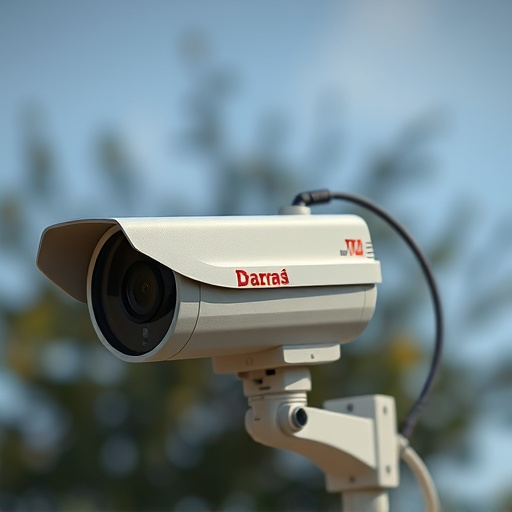Strategic placement of dummy security cameras at 5-10 feet (1.5-3 meters) above ground, adhering to height guidelines, effectively deter criminals by simulating constant surveillance in high-visibility areas like entry points and windows, enhancing both perceived and actual security indoors and outdoors. Realistic positioning, angles, and detail boost believability.
In today’s world, security cameras serve as a crucial deterrent for potential criminals. However, not all surveillance systems need to be active. Dummy security cameras, with their strategic placement, can significantly enhance home and business safety without breaking the bank. This article explores the art of dummy camera placement, focusing on optimal height guidelines (Dummy Security Camera Height Guidelines), visual discrepancies, and advanced strategies for both indoor and outdoor environments, ensuring maximum effectiveness in deterring crime.
- Understanding Dummy Cameras: Placement Basics
- Optimal Height for Effective Deterrence
- Visual Discrepancy: Tricks of the Trade
- Location Matters: Indoor vs Outdoor
- Advanced Strategies for Realistic Simulations
Understanding Dummy Cameras: Placement Basics
Dummy security cameras, often used as a deterrent or for cosmetic purposes, play a vital role in enhancing perceived security. Their placement should be strategic to maximize their effectiveness. In terms of dummy camera height guidelines, general best practices suggest positioning them at eye level or slightly elevated. This mimics real surveillance equipment and creates the illusion of constant observation, deterring potential intruders.
When determining dummy camera placement, consider areas with high visibility, such as entry points, windows, and common gathering spots. Avoid placing them in obvious locations that could be easily bypassed, as criminals often spot fake cameras quickly. Instead, nestle them strategically within the environment to create an authentic-looking security network.
Optimal Height for Effective Deterrence
The optimal height for security camera placement is a crucial factor in their effectiveness, especially when using dummy or fake cameras as a deterrent. Studies have shown that mounting security cameras at heights between 5 and 10 feet (approximately 1.5 to 3 meters) above ground level offers the best balance between visibility and deterrence. This range ensures that potential criminals can clearly see the camera, making them more likely to avoid malicious activity.
Adhering to dummy security camera height guidelines of around 7 feet (2.1 meters) off the ground is recommended for maximum impact. This height allows for a wide field of view while remaining relatively unobtrusive, enabling it to serve as a credible deterrent in various environments, from residential properties to commercial spaces.
Visual Discrepancy: Tricks of the Trade
In the realm of security camera placement, one often overlooked tactic is the art of visual discrepancy. While dummy or fake security cameras are commonly used as deterrents, their strategic placement can be a game-changer. These faux cameras mimic real ones but serve as decoys, luring potential intruders with false security signals. The key to success lies in adhering to specific height guidelines for dummy security camera placement. Typically, these cameras should be positioned at eye level or slightly below, creating the illusion of a comprehensive surveillance system.
By doing so, would-be criminals may pause to assess their surroundings, believing they are under constant watch. This strategic visual discrepancy can enhance the overall security of an area, even if the cameras themselves lack actual recording capabilities. It’s a subtle yet effective way to deter crime and create a sense of vigilance in otherwise unsuspecting spaces.
Location Matters: Indoor vs Outdoor
The placement of dummy security cameras, or fake cameras, is a strategic art that can significantly impact the perceived and actual level of security in both indoor and outdoor spaces. Location plays a pivotal role in this strategy. Indoor environments require different considerations than outdoor areas. For instance, dummy cameras should be positioned at heights that align with real camera guidelines for optimal coverage. Generally, placing them at eye level or slightly elevated is recommended to mimic genuine surveillance equipment. This strategic height placement can deter potential intruders as it suggests an active security system.
In contrast, outdoor spaces might demand a different approach. Factors such as weather conditions and visibility must be considered. Dummy cameras should be mounted higher outdoors to account for potential obstructions like trees or buildings, ensuring they remain visible and effective deterrents. The guidelines for dummy camera height placement are versatile and adaptable, allowing for customized security solutions tailored to specific locations.
Advanced Strategies for Realistic Simulations
To create convincing fake security camera simulations, go beyond basic placement. Advanced strategies involve understanding real-world camera heights and angles. Refer to dummy security camera height guidelines for accurate representations. Positioning cameras at typical eye-level (around 5–6 feet) ensures realism, mimicking actual surveillance setups. This approach not only enhances the illusion but also provides a more natural perspective for viewers.
Additionally, vary camera angles and viewpoints. Don’t limit yourself to straight-on shots; simulate realistic surveillance by incorporating subtle changes in elevation and rotation. This adds depth and authenticity, making the simulation harder to discern from genuine footage. Remember, attention to detail in these advanced strategies significantly boosts the overall believability of your fake security camera setup.
Fake security camera placement is a powerful tool to deter crime, but it requires strategic thinking. By understanding the basic principles, such as optimal height guidelines (Dummy Security Camera Height Guidelines) and visual discrepancy tactics, you can create realistic simulations both indoors and outdoors. Advanced strategies further enhance their effectiveness. Remember, while these dummy cameras don’t capture real footage, their strategic placement sends a clear message to potential intruders.
